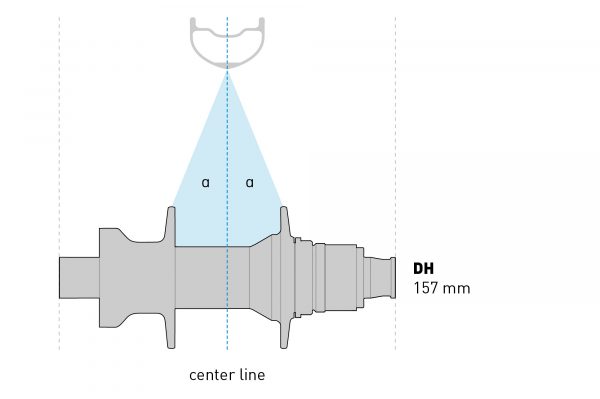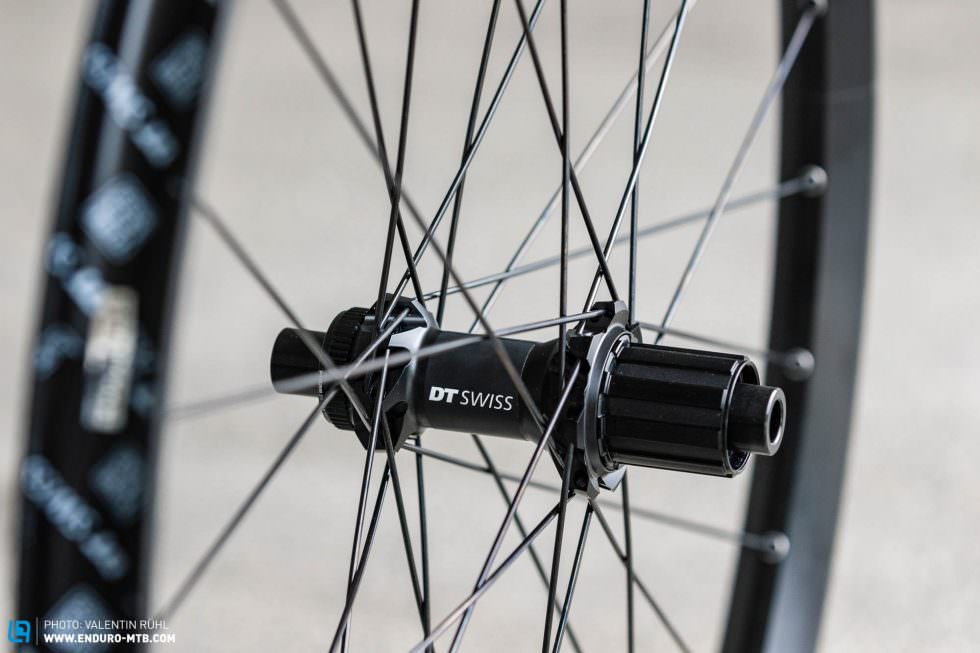Super Boost Plus 157 rear axle standard – is it here to stay?
When Pivot released the Switchblade trail bike in 2016, one small detail caused more of a stir than the bike itself – it had 157 mm rear axle spacing, which Pivot called Super Boost Plus. At the time of its launch, Super Boost Plus compatible components such as cranks, hubs and chainrings were limited. Fast forward to 2020, and these components are readily available. Is the 157 mm standard here to stay?

What is Super Boost Plus?
Super Boost Plus (or SB+ for short), is a “standard” of rear axle spacing for trail and enduro bikes. Introduced by Pivot Cycles in 2016, SB+ builds on the increased rear wheel and frame strength brought about by the change to Boost 148 mm spacing. Super Boost Plus goes one step further, widening the rear dropouts to 157 mm. This number wasn’t pulled out of thin air, however, and instead borrowed from the world of downhill bikes which have been using 157 mm rear axle spacing as their standard for some time now but without the extra-wide flange spacing. As a result of the wider rear dropouts, the chain line standard is also increased to 56 mm. Originally only used by Pivot, Super Boost Plus spacing has now been incorporated by a number of brands such as Evil, Knolly (who call it TRAIL157) and Devinci.

What’s the difference between Boost 148 and Super Boost Plus?
The most important benefit of using 157 mm Super Boost spacing is that wider hubs allow for wider flange spacing. The wider apart the flanges (the part of the hub where spokes are attached) sit, the wider the spoke bracing angle. Equally important is the ratio between the drive- and non-drive-side spoke angles. Ideally, both angles would be the same, resulting in even spoke tension. However, this is not possible with Boost 148 as the cassette body takes up a decent amount of space on the hub, which forces the drive-side flange further inwards. As a result, the flanges don’t sit symmetrically on the hub but are shifted towards the non-drive side. The rim is centred over the hub, not the flanges: this results in a so-called “dish”.



Compared to Boost 148, SB+ allows for a more even tension ratio between the drive side and non-drive side spokes. Super Boost Plus wheels have a dish ratio of around 60/40, compared to Boost 148, which has a less even dish ratio of 62/38. The less dish is required, the more even the tension ratio and the stronger and stiffer the wheel.
Fun fact for all SB+ haters: On 157DH hubs, the ratio is even.

What are the claimed benefits of Super Boost Plus?
The overall result of the wider flange spacing allowed by a Super Boost Plus hub is a stiffer and stronger wheel build, which is especially beneficial to long travel 29ers and eMTBs, where wheel loads are often very high. While we’re a big fan of strong and durable wheels, increased stiffness alone is not always the ultimate goal. Due to the chain line moving further outwards, using SB+ gives bike designers more space and freedom in designing the drive-side chainstay. Depending on their design, this may increase tire clearance and/or the stiffness of the rear end, as well as shorten the chainstays. However, with the current trend of 29×2.5” we rarely have issues with tire clearance, especially as the super-wide 2.8” Plus tires are disappearing from the scene – we won’t miss them. As for stiffer and shorter rear ends, these factors should also fit with the overall geometry and intended use of the bike. The best enduro and trail bikes out there are already very stiff, and there comes a point where increased stiffness can lead to an uncomfortable ride feel.

What are the cons?
The first downside is not a surprising one – it’s another new standard. However, before we all take to the forums, let us remember that without new standards, innovation is impossible. The real question is if the improvements outweigh the cons.
Compatibility
Of course, a new standard brings with it compatibility issues. Super Boost Plus requires not only new 157 mm hubs, but also cranksets and chainrings that are compatible with the required 56 mm chain line. Luckily for SB+ fans and converts, all major drivetrain, wheel and crankset/chainring manufacturers are now offering Super Boost Plus compatible options.
Q factor
Due to the wider dropouts and chainstays, and to meet the required 56 mm chain line manufactures had to engineer wider cranksets for Super Boost Plus frames. The result is a bigger Q factor – the distance from the outside of one crank arm to the outside of the other crank arm. The bigger the Q factor, the wider apart your feet are on the pedals. With a standard 93 mm press-fit or 73 mm threaded bottom bracket, the Q factor of a Super Boost Plus bike sits at 173-177 mm, compared to 168-177 mm on a Boost 148 bike. However, this is only really a change for XC riders, as enduro riders usually run wider pedals mounted to 177 mm Q factor cranks anyway.
Heel rub can be an issue
One potential negative of wider chainstays and increased tire clearance is heel rub, due to the chainstays butting out closer to your heels and reducing the amount of space you have to move your feet on the pedals.

What does the industry think?
We reached out to a number of the biggest players in the industry, pro and against SB+, and asked them their opinion on the matter. Is Super Boost Plus dead, or is it here to stay? Pivot, who introduced the standard in 2016, are still very much behind the idea and have used the standard for their latest all-rounder trail bike, the Pivot Switchblade 2020.
“For Pivot, we are able to design a bike with better tire clearance, better strength and stiffness in key areas – sometimes with lighter weight due to better optimization. Also, spoke tension is more even which adds big durability to the wheel structure as well. I see it as THE trail and longer travel bike standard. There really are no downsides once you get past the XC category. I don’t think it’s the best standard for XC because the rest of the bike is not as burley and every gram matters.”

Canyon responded by stating that they are still investigating and see both pros and cons to the standard. However, it has not been a necessity for them, as they are already happy with the performance they have using Boost 148 mm.
Merida responded with a very anti-SB+ view. They claim that the wider rear spacing causes heel rub, and are put off by the fact that it makes existing Boost wheels useless. In order to gain extra tire clearance, they are focussing their developments around cranksets with a 55 mm chain line, offered by Shimano, which gives them an extra 3 mm of space between the chainring and the chainstays to optimise rear end stiffness and clearance, whilst still using Boost 148 spacing at the dropouts.

When we reached out to Trek, they responded with a similarly anti-SB+ view, stating: “We will not be introducing 157mm spacing in the near future. It’s not for a lack of pioneering spirit … We have looked at this closely and the pain of moving to 157mm spacing is not worth the small gains. Between frame and drivetrain improvements, we are able to get the features and performance from 148mm spacing.”

From our customer service point of view and also confirmed by our test laboratory and field tests, we see no reason to replace the established Boost 148 mm standard. – DT SWISS
But what do the wheel and hub manufacturers have to say? We asked industry giants DT Swiss for their opinion: “When we changed from 142mm to Boost 148mm, we were already able to realise a flatter spoke angle, which led to a not only stiffer but above all more stable wheel construction. The 157mm DH standard was still a bit superior to the Boost standard due to its symmetrical and wide flange distance. With the new 157 Super Boost Plus standard, only the left flange moves significantly towards the brake interface, resulting in an even flatter spoke angle. In theory, all standards have their advantages and disadvantages, but it is important to see the bike as a complete system. From our customer service point of view and also confirmed by our test laboratory and field tests, we see no reason to replace the established Boost 148 mm standard. As a supplier to the bike industry, however, we meet the wishes of bike manufacturers and customers and of course do not want to block any innovation. Another standard only creates more confusion for the end consumer, so in the near future we will design all 157mm hubs with the wide Superboost flange distance. For the downhill use of these hubs nothing changes in principle, except different spoke lengths.”
What do we think?
First of all: don’t deduce a bike’s performance from its rear axle standard – Super Boost Plus won’t make a bad bike good or a good bike bad. Yes, it’s true that Super Boost Plus allows for stronger and more durable wheels, stiffer frames and more tire clearance. However, it’s important to remember that these gains are only marginal. Over the years, we haven’t seen any real issues with the current Boost 148 mm standard – and it has been the standard for quite some time. In our opinion, the changes that Super Boost Plus bring don’t outweigh the fact that there will be a lot of people out there with useless wheels after buying a new SB+ bike. There are many ways to improve a bike – taking the easy route and introducing a new standard with only marginal changes in our opinion isn’t the right one.

Did you enjoy this article? If so, we would be stoked if you decide to support us with a monthly contribution. By becoming a supporter of ENDURO, you will help secure a sustainable future for high-quality mountain bike journalism. Click here to learn more.
Words: Photos: Diverse








